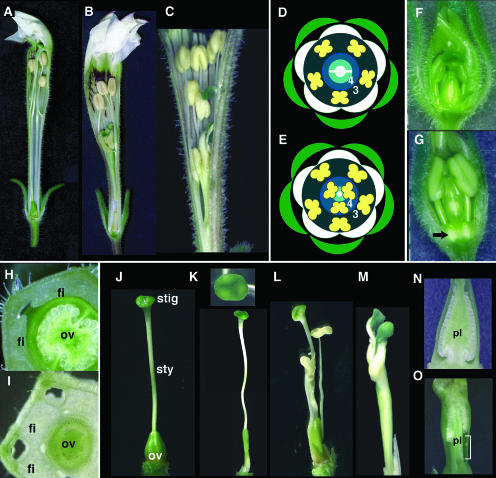Figure 3.
Phenotypes of phsup1 Mutants in Flower Development.
The wild-type flower consists of four concentric whorls of organs: five sepals, five petals, five stamens, and a pistil composed of two carpels. Whorl 3 (3) and whorl 4 (4) organs are indicated. Number and identity of organs in whorls 1, 2, and 3 in phsup1 mutant flowers are the same as those in the wild type, but two or three extra stamens were generated in whorl 4.
(A) to (C) Side views of P. hybrida flowers in wild-type (A) and phsup1-tm1 ([B] and [C]) plants. A few petals and sepals have been removed to show whorl 4 organs.
(D) and (E) Flower diagrams of wild-type (D) and phsup1 mutant (E) flowers.
(F) and (G) Side views of 10-mm flower buds in wild-type (F) and phsup1-tm1 (G) plants. Extra tissues are seen at the bases of whorl 3 stamens in phsup1-tm1 flowers as indicated by an arrow (G).
(H) and (I) Transverse sections at the basal part of 10-mm flower buds in wild-type (H) and phsup1-tm1 (I) plants. fi, filament; ov, ovary.
(J) to (M) Whorl 4 organs in wild-type (J) and phsup1-tm1 ([K] to [M]) plants. Wild-type pistils consist of two fused carpels (J). In phsup1-tm1, pistils often consisted of three carpels, and the style shows a stamen filament-like feature (K). Extra stamens were frequently generated and were usually fused with a pistil to various extents ([L] and [M]) (i.e., stamens were fused with an ovary at the base of their filaments [L] or fused with a style throughout the entire filament [M]). ov, ovary; stig, stigma; sty, style.
(N) and (O) Ovaries in wild-type (N) and phsup1-tm1 (O) plants. The bottom of the placenta was elongated in phsup1-tm1 ovaries as indicated. pl, placenta.

